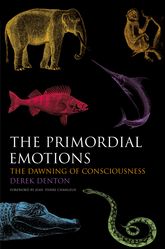The Primordial Emotions
Primordial Emotions are the fundamental, innate emotions that are hardwired into the brain of all sentient beings. These emotions are considered to be the building blocks of the more complex, nuanced emotions that individuals experience. They are thought to have evolved early in the history of life to help organisms survive by making rapid, adaptive choices in response to environmental stimuli. The concept of primordial emotions suggests that these basic feelings are universal across human cultures and, to some extent, even across different species.
Overview[edit | edit source]
Primordial emotions are deeply rooted in the brain's limbic system, particularly in structures such as the amygdala, hypothalamus, and periaqueductal gray (PAG). These areas of the brain are involved in the processing and regulation of emotions, and they are interconnected with the neocortex, which is responsible for higher-order brain functions such as reasoning, planning, and social behavior. The primordial emotions include, but are not limited to, fear, anger, joy, sadness, and disgust. These basic emotions serve essential survival functions; for example, fear triggers the fight-or-flight response, while joy encourages behaviors that are beneficial for well-being and social bonding.
Function and Evolution[edit | edit source]
The primary function of primordial emotions is to enable quick, instinctive responses to environmental challenges and opportunities. For instance, the emotion of fear can lead an organism to flee from a predator, while disgust can prevent it from eating harmful substances. From an evolutionary perspective, primordial emotions have been selected for because they increase an organism's chances of survival and reproduction.
Over time, as organisms became more complex, so did their emotional responses. In humans, primordial emotions form the foundation upon which more complex social emotions, such as guilt, shame, and pride, are built. These higher-order emotions are crucial for navigating complex social landscapes and forming lasting social bonds.
Research and Implications[edit | edit source]
Research into primordial emotions spans several disciplines, including psychology, neuroscience, and evolutionary biology. Studies often involve examining the neural mechanisms underlying emotional responses and comparing emotional behaviors across different species to understand their evolutionary origins.
Understanding primordial emotions has significant implications for various fields. In psychology and psychiatry, insights into these basic emotions can improve the diagnosis and treatment of emotional disorders. In neuroscience, studying the brain structures involved in primordial emotions can shed light on the neural basis of emotion and consciousness. Furthermore, in artificial intelligence (AI), insights from the study of primordial emotions are being used to develop more sophisticated, emotionally intelligent machines.
Conclusion[edit | edit source]
Primordial emotions are a fundamental aspect of the emotional lives of humans and other animals. They are the basic, instinctive responses that have evolved to help organisms navigate their environments and survive. Understanding these emotions not only provides insights into the nature of human emotion and its evolutionary origins but also has practical applications in improving mental health treatment, enhancing emotional intelligence in AI, and fostering empathy and understanding across cultures.
Search WikiMD
Ad.Tired of being Overweight? Try W8MD's physician weight loss program.
Semaglutide (Ozempic / Wegovy and Tirzepatide (Mounjaro / Zepbound) available.
Advertise on WikiMD
|
WikiMD's Wellness Encyclopedia |
| Let Food Be Thy Medicine Medicine Thy Food - Hippocrates |
Translate this page: - East Asian
中文,
日本,
한국어,
South Asian
हिन्दी,
தமிழ்,
తెలుగు,
Urdu,
ಕನ್ನಡ,
Southeast Asian
Indonesian,
Vietnamese,
Thai,
မြန်မာဘာသာ,
বাংলা
European
español,
Deutsch,
français,
Greek,
português do Brasil,
polski,
română,
русский,
Nederlands,
norsk,
svenska,
suomi,
Italian
Middle Eastern & African
عربى,
Turkish,
Persian,
Hebrew,
Afrikaans,
isiZulu,
Kiswahili,
Other
Bulgarian,
Hungarian,
Czech,
Swedish,
മലയാളം,
मराठी,
ਪੰਜਾਬੀ,
ગુજરાતી,
Portuguese,
Ukrainian
Medical Disclaimer: WikiMD is not a substitute for professional medical advice. The information on WikiMD is provided as an information resource only, may be incorrect, outdated or misleading, and is not to be used or relied on for any diagnostic or treatment purposes. Please consult your health care provider before making any healthcare decisions or for guidance about a specific medical condition. WikiMD expressly disclaims responsibility, and shall have no liability, for any damages, loss, injury, or liability whatsoever suffered as a result of your reliance on the information contained in this site. By visiting this site you agree to the foregoing terms and conditions, which may from time to time be changed or supplemented by WikiMD. If you do not agree to the foregoing terms and conditions, you should not enter or use this site. See full disclaimer.
Credits:Most images are courtesy of Wikimedia commons, and templates Wikipedia, licensed under CC BY SA or similar.
Contributors: Prab R. Tumpati, MD

